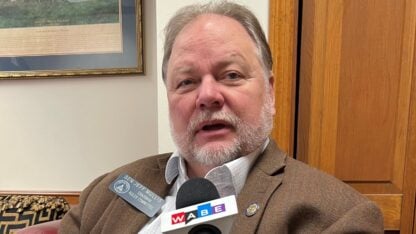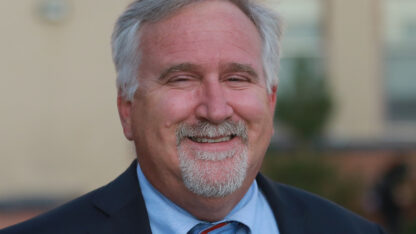What Does ‘School Turnaround’ Look Like?

Stephanie Johnson, right, walks with state Schools Superintendent Richard Woods, center, through the halls of Maynard Jackson High School in Atlanta. Johnson, now Georgia’s deputy superintendent for school improvement, has been credited with turning around three Atlanta-area high schools as a principal.
Georgia Department of Education
Georgia education officials and lawmakers have turned their attention lately to the concept of “school turnaround.”
The idea is to drastically improve schools considered “low-performing” or not meeting state standards. The Georgia Legislature passed a law in 2017 requiring the state to hire a Chief Turnaround Officer to oversee school turnaround efforts. The state board of education tapped Dr. Eric Thomas for that role in October.
However, the work isn’t easy.
To find out how it’s done, WABE spoke with Stephanie Johnson. She’s Georgia’s deputy superintendent for school improvement. She’s also credited with turning around three Atlanta-area high schools as a principal.
Most recently, she led Atlanta’s Maynard Jackson High School. She was hired in 2012 and knew she had her work cut out for her.
“There were many deficits across operations and behavior as well as instructional performance and leadership that were [contributing] to low-performance on tests,” Johnson said.
However, she also knew she needed to take on one issue at a time.
“You’re not going to just walk into a school situation and just say to a child, ‘We’re going to teach you Shakespeare,’” she said. “’We’re going to teach you algebra, and you’re going to get your test scores up,’ because they don’t care.”
So, Johnson started with one of the school’s biggest problems: gang violence.
“We were dealing with some drug deals, and police coming in on Monday morning with probation officers, that kind of thing,” she said. “I wanted to put a stop to it.”
She found out who the gang leaders were and started sitting with them at lunch.
“One day at lunch, we’re sitting down talking to one of the young men, his name was Nick,” Johnson said. “I said, ‘Nick, tell me why y’all act a fool out in the street. I don’t get this.’”
Nick told her, “Mrs. Johnson, I’m just going to tell you the truth: when kids don’t have anything to do, we can get into some trouble.”
Johnson let Nick know she was willing to negotiate … sort of.
“What would it take?” Johnson asked Nick. “What would it take for you not to get in trouble? Because y’all are embarrassing me. The police coming in here and all of that? Y’all are embarrassing me.”
Nick asked her, “Can you get me a job?”
She told him, “If y’all will stop acting up, I’ll get you a job.’”
That’s what Johnson did. She didn’t stop with Nick. She says school officials helped more than 500 people find jobs for students and their parents.
“We just called [businesses], and everybody we called in that community — the local bakery, the local grocery stores — they all hired our kids,” she said.
Then the school created a system. Students could apply for jobs if they had good attendance and good grades. Soon afterward, Johnson says things started to change.
“Violence is going down; crime is going down,” she said. “We started watching [the] graduation rate go up. Test scores start going up.”
Jackson’s graduation rate increased more than 20 percentage points during Johnson’s tenure as principal.
However, Johnson says the school’s success wasn’t just a result of getting students jobs. She also met with members of the community to gauge their expectations and commitment to the school. She was surprised by the items on their wish list.
“They wanted an [International Baccalaureate] program,” she said. “They wanted an [Advanced Placement] program. They wanted early college, foreign language, world travel. They wanted everything.”
Johnson told them she’d do it if they backed her up. She says they stepped up to the plate. Businesses and other stakeholders donated money. College students volunteered to help with robotics clubs and science projects. Parents helped create bike clubs and rooftop gardens. Teachers volunteered to coach sports teams.
“My thought in turnaround at that point was, ‘I’m going to come in and I’m going to fix you academically,’” Johnson said. “But then I realized turnaround is not just academics — and I’d done it twice — turnaround is what you do to build, accelerate and engage your entire community in a process that can be sustainable and meets the needs of the stakeholders who live there.”
Now that Johnson leads school improvement efforts for the entire state, she wants to help other schools engage and serve their communities.
“Even if you are a school district that you are so poor you don’t have extra funds, we have that bucket here,” she said. “So, whenever you have a gap, you can call and say, ‘Stephanie, how do we get grants and partnerships?’ And I’m able to have this bucket of grants and partners around you and say, ‘Here are some.’ I think that’s our role.”








